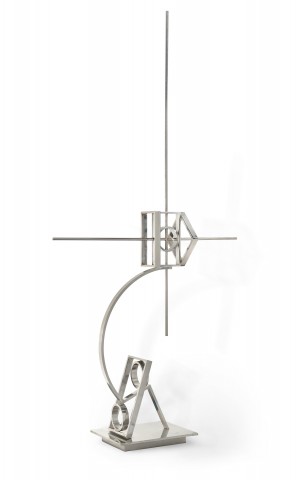NO. 274B, 1974
ROBERT KLIPPEL
welded steel
259.0 cm (height)
Richard and Joan Crebbin, Sydney
Christie’s, Sydney, 17 August 2008, lot 1084 (as ‘Construction’)
Private collection, Sydney
Robert Klippel, Sculpture since 1970, Watters Gallery, Sydney, 21 November – 8 December 1979, cat. 1 (illus. in exhibition catalogue)
Gleeson, J., Robert Klippel, Bay Books, Sydney, 1983, pp. 331, 334, 474 (as ‘Opus 274b’)
Edwards, D., Robert Klippel: Catalogue Raisonné of Sculpture, (CD–ROM), Deborah Edwards and the Trustees of the Art Gallery of New South Wales, Sydney, 2002 (illus. CD–ROM Artworks, as ‘no. 274b’)
No 274a Metal Construction, brazed steel, 29.3 cm height, in the Crebbin Collection, Sydney, illus. in Gleeson, op cit, p. 330
Exerting his creativity with a new formal vocabulary, no longer reliant on the found forms of industrial and mechanical detritus, Robert Klippel’s constructions of early 1970s were meticulously drawn in space with a strict rational syntax of right angles, perfect circles and squares in graduated sizes, arranged and assembled in brazed steel. The high formalism of these works demonstrates the continuity of these aesthetic concerns throughout Klippel’s oeuvre. While several examples of this suite were monumental in feel despite their modest size, such as No. 266a (lot 3), these became the first, and only, sculptures for which Klippel created industrially produced enlargements. No. 274b, 1974, striking in its refined rectilinear severity and gleaming clean edges, is the most successful of these enlarged geometric sculptures, with both versions acquired for the collection of Richard and Joan Crebbin, Klippel’s consistent patrons.
Klippel, swept along in the popular penchant for large paintings and sculptures, set aside his concerns of over-refinement and authenticity to contact Les Wild, who operated a small welding firm in Rozelle. Having already attracted sculptors like Tony Coleing to his workshop, Wild’s reputation for skill with difficult constructions preceded him in Sydney’s artistic circles. While Klippel’s smaller, ‘a’ versions of these sculptures were made with pre-cut sections of steel piping brazed together by hand in the studio, the process of enlargement with required third party industrial welding. Fabricating a copy ten times the size of the maquette required small adjustments to proportions in order to rebalance the structure, quality control and aesthetic judgment provided by the constant presence of the artist in the welding workshop.
The first sculpture Klippel chose to fabricate on a large scale with Wild was to fulfil a site-specific commission in a new landscaped garden of a Melbourne collector. By same token, 274b, produced years later was installed with great care in a garden, that of the Crebbins, whose Walter Burley-Griffin Castlecrag residence Klippel knew well. In this context, set against the view of Sydney harbour, the design of 274b acquired a relevance and gravitas that was absent from its smaller form. The gleaming exactitude derived from the industrial process combined with the arrangement of Klippel’s geometric section endowed 274b with the appearance of a scientific sighting instrument. Its rods intersecting at cross-hairs in the eye of the work, the construction interacts directly and closely with its expanded environment.
Although the loss of human touch was a concern for Klippel in the initial stages of fabrication, in No. 274b, the technical perfection of an industrial finish and spartan discipline of its geometric construction dovetailed to create a masterful sculpture. While governed by static straight lines and right angles, save for wide arced segment for the foot, the arrangement of Klippel’s guiding lines invokes careful movement. Perhaps providing the impression of a gradual alignment of each part working in tandem to provide focus and clarity? Gleeson provides a clear assessment of the merits of this sculpture in his 1983 monograph ‘cool as an equation and loaded with the authority of logic, it stands in complete mastery of its space. It is undeniable as a theodolite or an astrolabe.’1
1. Gleeson, J., Robert Klippel, Bay Books, Sydney, 1983, p. 331
LUCIE REEVES-SMITH
